#Queen of Portugal
Explore tagged Tumblr posts
Text
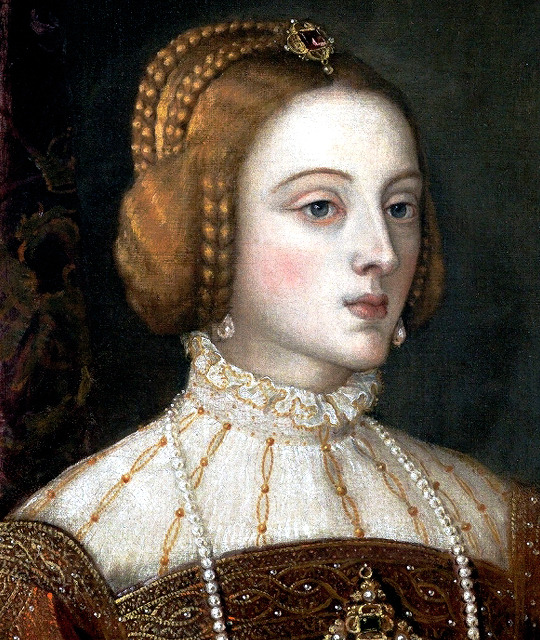

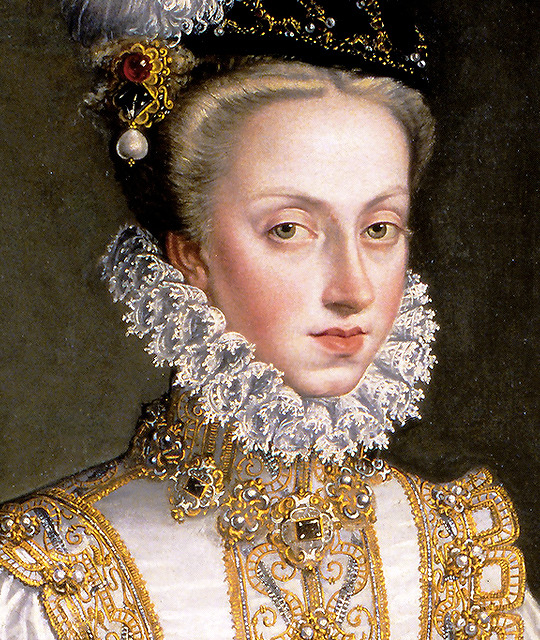
ISABELLA OF PORTUGAL by Titian, 1548 JOANNA OF AUSTRIA by Sánchez Coello, 1557 ANNA OF AUSTRIA by Bartolomé González y Serrano, 1570
#historyedit#isabella of portugal#joanna of austria#juana of austria#anna of austria#queen of portugal#queen of spain#princess of portugal#history#women in history#house of aviz#house of habsburg#titian#alonso sanchez coello#bartolome gonzalez y serrano#art#renaissance art#gramma isabella#joanna was isabella's daughter#and anna was joanna's niece#thus isabella's granddaughter#edit#x#i just love how anna looked more like her aunt than her own mom 🥹#and both joanna and anna looked like their grandma
418 notes
·
View notes
Text

Maria II, Da Glória, Queen of Portugal (1819-1853)
Artist: William Corden the Younger (English, 1819-1900)
Date: c.1850-1900
Medium: Oil on Panel
Collection: Royal Collection Trust, London, United Kingdom
Description
The Queen of Portugal is depicted wearing the ribbon of the Orders of Christ, St Benedict of Avis and St James of the Sword. She was the daughter of Pedro IV, King Portugal, who had abdicated in 1826. She had visited London in 1829 and 1833 and on the earlier visit had been painted by Sir Thomas Lawrence for George IV. She married in 1836, as her second husband, Prince Ferdinand of Saxe-Coburg-Gotha, who was made King Consort in 1837 and whose portrait is also in the Royal Collection.
Corden had been sent to Lisbon in 1850 and painted a pair of full length portraits of the King and Queen but these do not appear to have survived. This head and shoulders portrait may have been cut out of the original full length painting, or may be a copy of the head from the original.
#portrait#oil on canvas#queen of portugal#william corden the younger#english painter#ribbon of the orders of christ#portuguese history#costume#tiara#woman#brooch#english art#royal collection trust
10 notes
·
View notes
Text

St. Elizabeth of Portugal (1271-1336).
#saints#elizabeth of aragon#queen of portugal#elizabeth of portugal#queen consort#house of barcelona#anscarids#house of ivrea#casa di ivrea#maison d'ivrée#kingdom of portugal#reino de portugal#santoral#a.i.#artificial intelligence#a.i. art
4 notes
·
View notes
Photo

Antonio Moro (Netherlandish, 1520-1586) Portrait of Anna of Austria (Cigales, 1549-Badajoz, 1580), Queen of Spain and Portugal, Detail, 1570 Kunsthistorisches Museum, Vienna
#Antonio Moro#netherlandish#art#fine arts#female portrait#anna of austria#queen of spain#spanish queen#fine art#oil painting#female#portrait#queen#queen of portugal#european art#western civilization
58 notes
·
View notes
Text
Catherine of Aragon's family-Maria of Aragon's depictions
This time I am going to do something bit different. I'm not going to show you just individual depictions and their sources. But also give the comentary abou their accuracy(or likely accuracy).
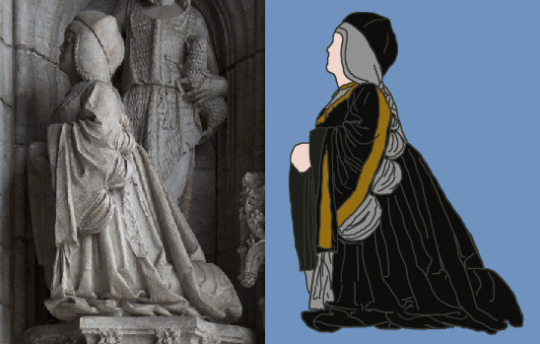
It is about damn time we learnt a bit about what does consist of portuguese fashion, and what doesn't.
Because I suspect among Maria's depictions there is a black sheep(a misidentified portrait). So this post is kind of me trying to assess if my suspicion is right...
Maria tends to be imo the most overlooked of the siblings. She and her husband got along, she wasn't the only son, nor ever became the heir...
But I'd not trust the sources which say she wasn't good looking.(Perhaps not as good looking as some of her siblings)
Not many of her depictions survive, they just as records often fell victim to the earthquakes. But there are two depictions which likely originate from her lifetime, or at least close to her lifetime.
1)Stained-glass window in the High Chapel of the Church of Saint Mary of Victory (Batalha Monastery, Leiria, Portugal), attributed to Francisco Henriques, c. 1510-1513:
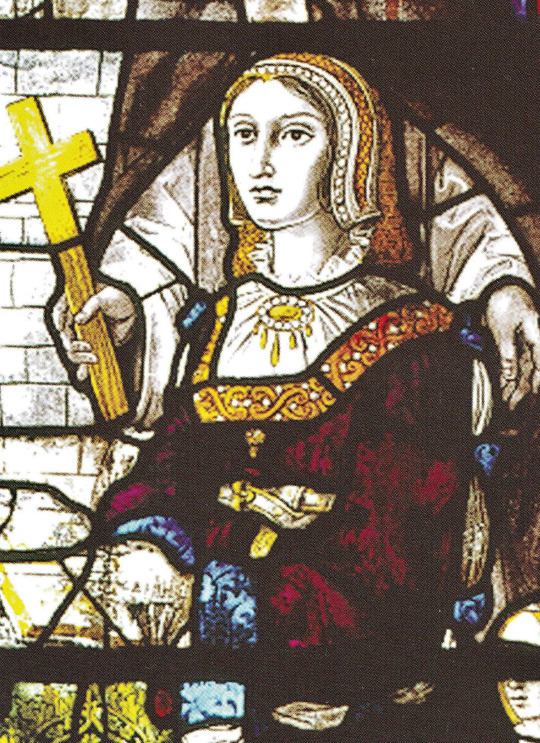
The little red dot in down left imo is out of place imo(window was smatched at some point), and imo belongs elsewhere.
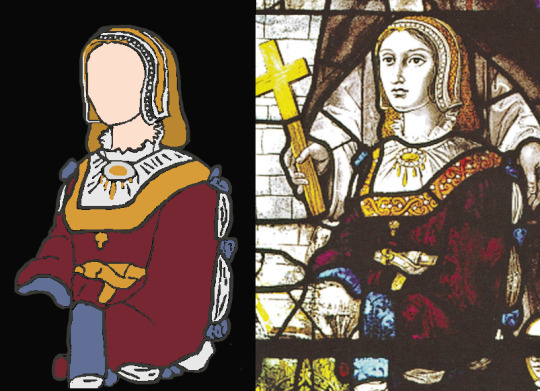
Otherwise I have nothing to say against the dress itself, it looks very Iberian and the similiarities to some of the religious artwork of the day is pretty damn awesome:
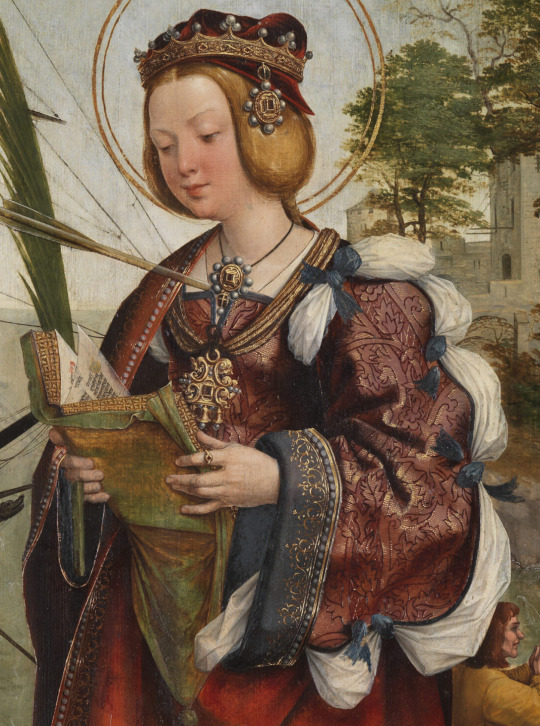
Even colour-scheme is same. (Although obviously different neckline and chemise, but that could be down to personal choice or different season.)
The wide decorative trim made gold and pearls can also be found coassionally in Portuguese art, I found it plenty of time in later source
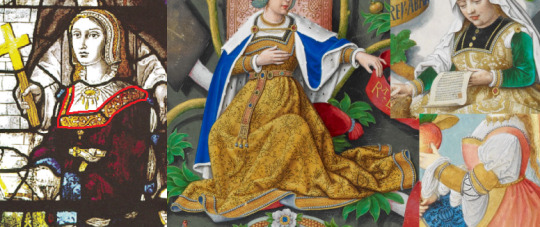
Genealogia dos Reis de Portugal(c.1530-1534)-which has outfits which are partially fiction partially true...
But i have bit of an issue with the headwear. It looks like french hood(at least from front)...kind of.

And I don't think it would be likely for Maria to wear French hood. Yes, it could have been introduced to Iberia by Margaret of Austria or Joanna...but would it linger after they either left or were locked up?
The artist was active in Portugal but native flemish(hence from part of Habsburg Netherlands), and I wonder if perhaps he got bit creative...
...But if you know a bit about french hoods...this is not historically accurate french hood of the time. It might look that way on first glance...but on 2nd? No. It more resembles french hoods after 1530s, than 1510s-where it definitely should have golden frill.
And I did my best to look through surviving portuguese art for depictions french hoods. And I found like 2 in total...which I only suspect might be french hood, because they are oddly depicted.
...And I am wondering if it could be separate headwear...something which resembles French hood at this angle.
So I am not ruling out french hood as impossible, but I am wondering if perhaps Portuguese had something similiar to french hood which was not very popular and got depicted just few times.
2)Maria's statue is from 1517-the year she died. It is located Mosteiro dos Jerónimos(Jeróminos Monastery) where the members of house Aviz are burried, including Maria herself (without effigy):

Idk if it is posthumous or not. But if posthumous, then the artist Nicolau Chanterene would likely be send to create it as commemoration of her life, and since employed by royalty, it's likely he'd have best sources about Queen...perhaps including access to her dresses etc.
The kneeling statue lost its hands(probably in earthquake), but it's still fine example of obviously iberian fashion:
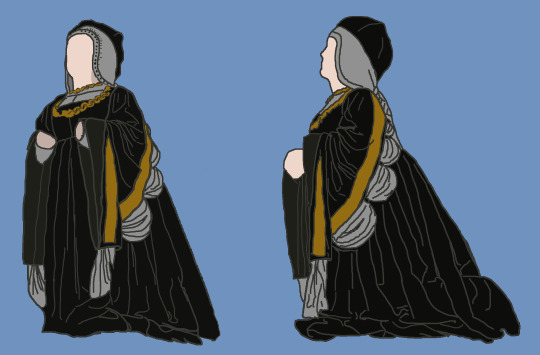
The cofia de tranzado, the fabulous sleeves...with bit of them upturned. All colours were picked by me...and it's obvious why I made the chain in gold, but why the wide trim in gold?
-because in closeup it has this kind of pattern, and I can't imagine it being anything other but golden with such pattern.
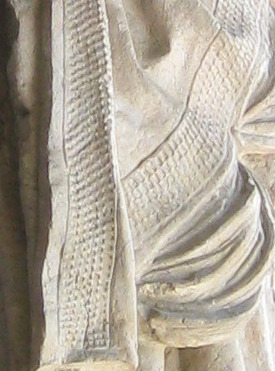
I could be wrong interepreting the statue, but the statue itself screams historical accuracy.
This painting has similiar golden trim imo-Nursing Madonna by Defendente Ferrari, in Uffizi Gallery:

(Although here sat directly at edge.)
Directly from Portugal is Retábulo de Santa Catarina(Museu Nacional de Arte Antiga, Lisbon) from allegedly 1540s(imo that's not correct date), where figure of St. Catherine has dress which look very close to Maria's:
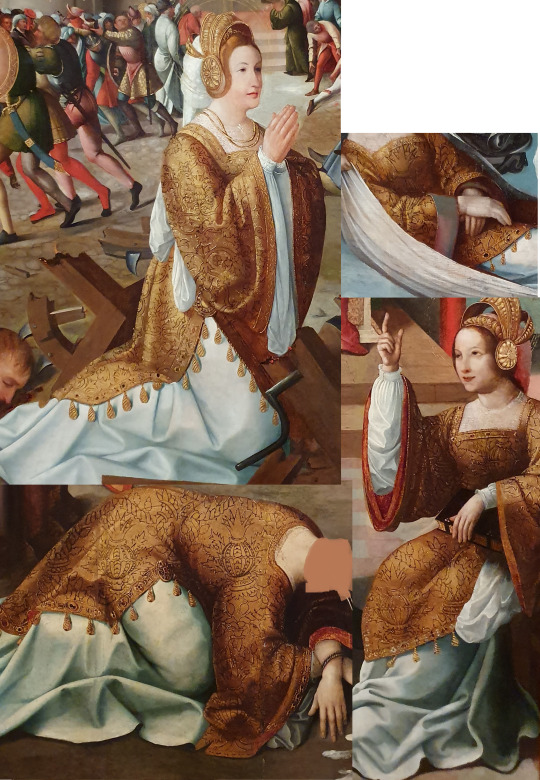
(I covered the cutt off neck. I don't want to breech any guidelines.)
But those dangling things and metalic headwear-those are the fantasy parts of the costume, and obviously it's much shorter than Maria's dress. But very similiar to fashion of the statue.
3)Portrait of Maria of Aragon, Belem Collection, created around 1720:
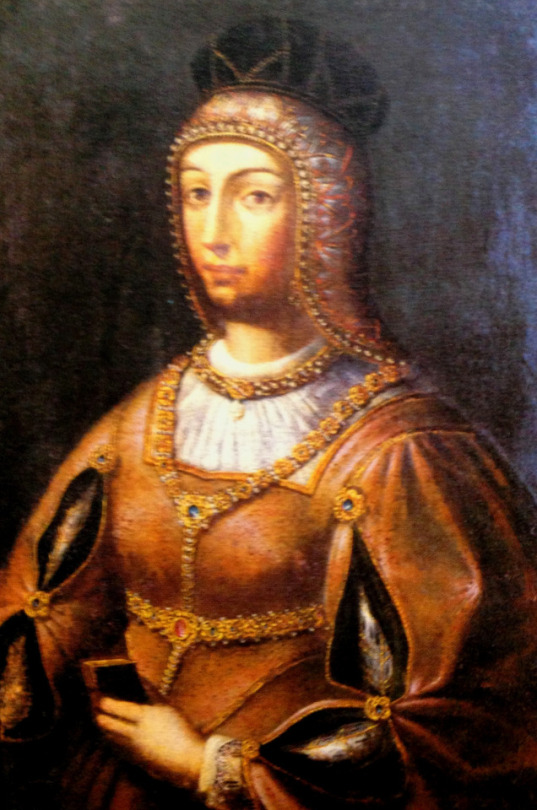
Despite being copy, this one is actually very close to the statue in many aspects. The jewelry placement, the height of waistline-it's same. The headwear is once again cofia de tranzado(perhaps bit more elaborate...)with different style of hat(which I can't place...could be alteration) and the rest of outfit is same as what we see in Spain in 1500s and 1510s.
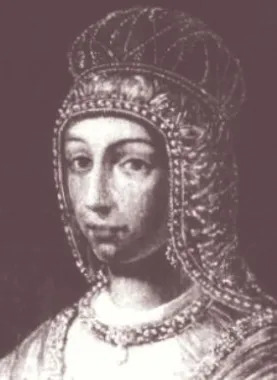
So except hat on top it looks historically accurate. Although cofia de tranzado being this heavily embroidered is probably add-on.
Within same collection there is also portrait of King Manuel, done at same time:

He also has golden gown decorated at edges with pearls and tbh it's quite similiar to yet another portrait of Maria:

4) Maria de Aragão e Castela, Rainha de Portugal
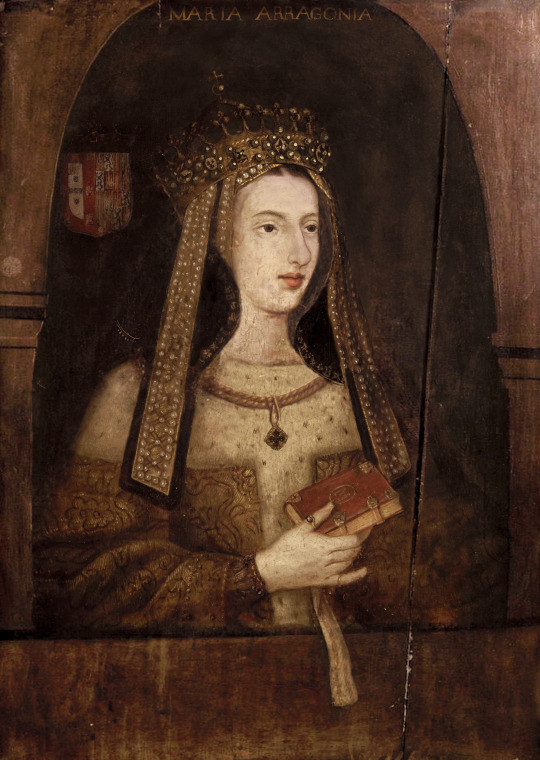
You can find it on wikipedia, which says the source is book called Infantas de Espanha, Rainhas em Portugal. It's author seem as historian, not art historian. And I am not putting blame upon him, for this mess. Overall the amount of weird things is so big, that I shall dedicate separate post to it.
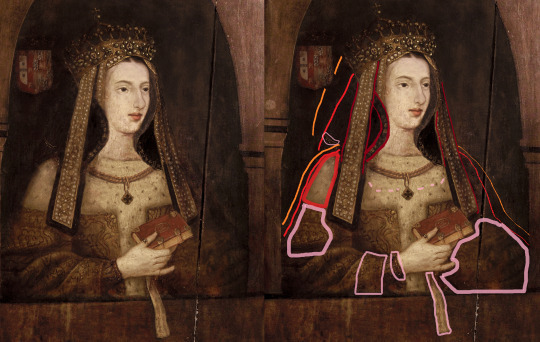
But long story short.
It's heavily altered, possibly photoshopped and never seem very Iberian to me. And after all research I did...I am even more convinced it's not Iberian fashion.
So either the fact somebody altered heck out of it has hid Maria's outfit so well, it no longer looks Iberian...Or it isn't Maria.
I know some of you like this portrait...but we have to be objective here...the misidentification happened in past a lot, and even today happen as well.
And the similiarities to Manuel's outfit in that portrait above could make people think the woman is his wife...Even if she isn't.)
We're going to take deep dive into the issue and then make conclusions. In meanwhile don't use it as inspiration for costume of Maria of Aragon. Seriously don't.
5)Fons Vitae by Colijn de Coter, 1518-posthumous depiction:
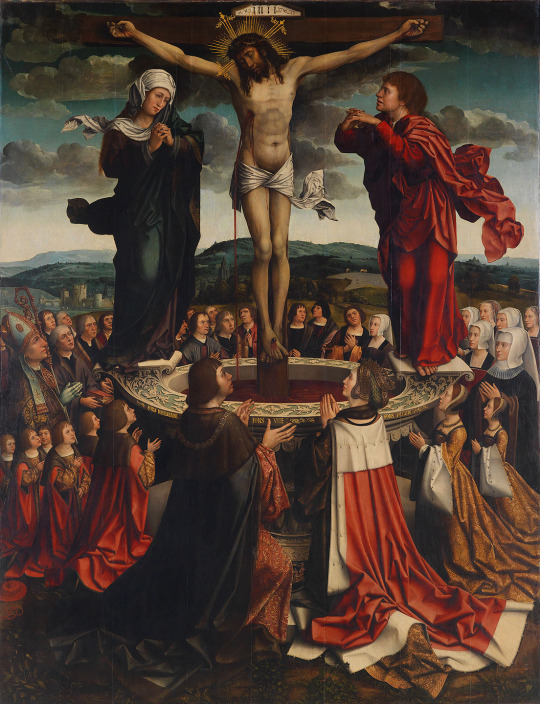
Is located in Museu da Misericórdia do Porto, Portugal. At lower part of painting is depicted King Manuel's family.
But I have to point out, that the artist never went to Iberia...So there are two opions here. Either the comission and creation occured with sketches of royal being sent to royals, or without.
If without, then these would not need to be accurate at all, and would be just generic figures...
Here the Portuguese princesses are depicted 100% in Netherlandish outfits from head to toe:
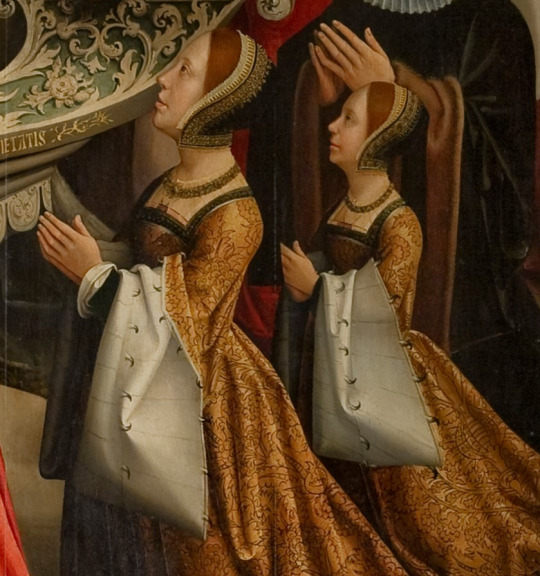
But is Maria too? Tbh idk. The headwear to me look lok more like belonging to 15th century and it's quite odd how she has two strands of hair styled beneat her ear, and then going above her forehead...plus traluscent part over it.
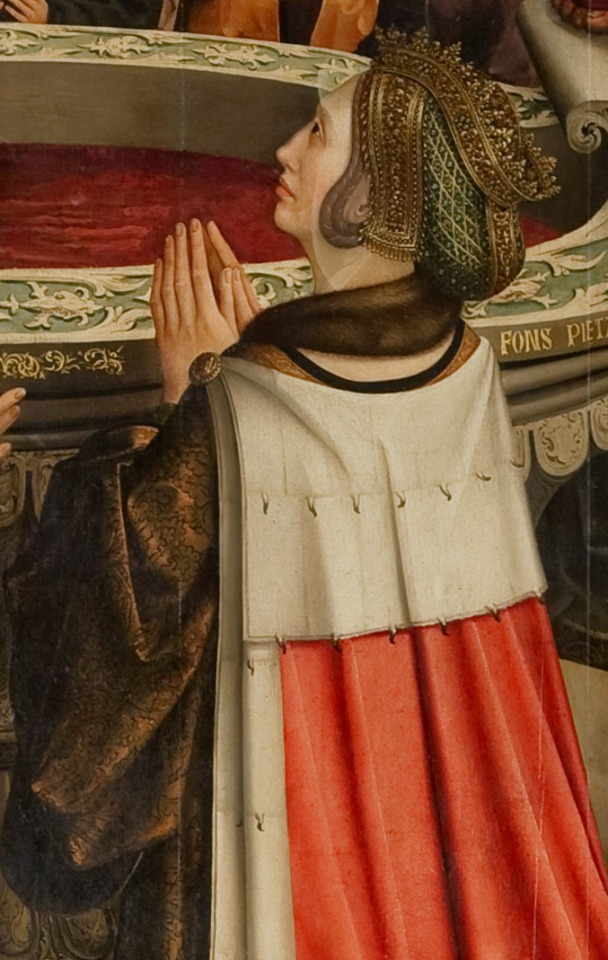
(Back of the dress also have similiar shape from back as that of St. Catherine.)
But then...there are big similiarities between the stain glass headwear and this(if we take the crown away):
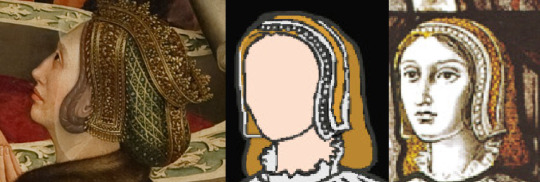

And if it indeed is same headwear...then from behind it's obviously not french hood...it just resembles its later form...in certain angles.
I'd not trust this depiction...100%...but I'd not throw it away as entirely inaccurate either. I just think the artist made it bit too much elaborate, because to him it seemed as those 15th century headwears...which were very elaborate.
I'd use the stain glass as the guide here. But I can't really tell exactly how the traluscent aprt adn hair are supposed to sit...and how layers work...But maybe some of you would like to give it a try.
If any of you know what this headwear is and how it is supposed to look like, write it in the comments, I'd love to know.
By the way...this might be same headwear:

With different back.
So that is all from me today, it was bit different than what I normally do. But I thought it necessary. I hope you've enjoyed it and see you next time.
15 notes
·
View notes
Text

Portrait of Infanta Mariana Victoria of Spain, Queen consort of Portugal, and former fiancée of Louis XV of France at Schloss Waldegg. Photo taken by me.
#Infanta Maria Victoria of Spain#Queen consort of Portugal#fiancée of Louis XV#House of Bourbon#Schloss Waldegg#Switzerland#Portrait#18th century
30 notes
·
View notes
Text
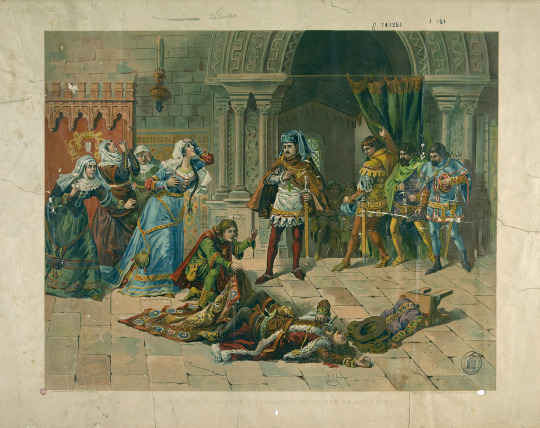
Leonor Telles before the corpse of Count Andeiro by Alfredo Roque Gameiro
#alfredo roque gameiro#art#leonor teles#joão fernandes andeiro#count andeiro#conde andeiro#portugal#portuguese#galician#nobleman#queen consort#medieval#middle ages#nobility#royal#royalty#mediaeval#history#europe#european
70 notes
·
View notes
Text
A segment on Queen Amelie’s Diamond Tiara from TVI’s interview with Infanta Maria Francisca.

The tiara was a wedding gift from Queen Amelie’s father-in-law, King Luís, in 1886. They show a picture of it with the other wedding gifts from the Portuguese royal family all made by the crown jewelers, Leitão & Irmão. On the right is a matching necklace from her mother-in-law, Queen Maria Pia, and on the left is a sapphire and diamond necklace from her husband, the future King Carlos.

I’ve never seen a picture of Queen Amelie wearing the matching necklace and it was most likely dismantled to create her Diamond Choker Necklace that is still with the former Portuguese royal family. She was photographed on at least one occasion wearing the sapphire necklace but I’m not sure what happened to it.
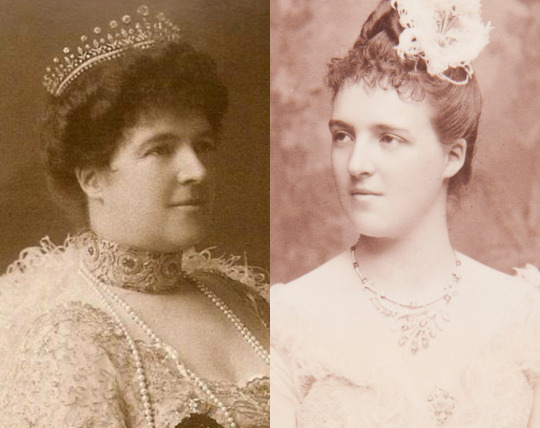
Any Portuguese speakers, does the jewelry expert, Eduardo Alves Marques, give any more information or say anything interesting?
#Tiara Talk#jewel documentary#Portugal#Portuguese Royal Family#Infanta Maria Francisca#Queen Amelie#tiara#diamond
153 notes
·
View notes
Text
epic win for online losers across the globe, finally meeting with my tumblr bestie @almighty-letu in portugal, we have been brought together by the epic highs and lows of eddsworld fanfiction. 🥰🥰💖💖💖 thanks eddsworld for creating the friendship of a lifetime! ❤️

#not letu being like three feet tall in person#short ass#short queen#thank you eddsworld#portugal is so pretty#<3
13 notes
·
View notes
Text







Royal Birthdays for today, December 31st:
Eleonora Gonzaga, Duchess of Urbino, 1493
Beatrice of Portugal, Duchess of Savoy, 1504
Go-Yozei, Emperor of Japan, 1572
Charles Edward Stuart, The Young Pretender, 1720
Isabella of Parma, wife of Joseph II of Austria, 1741
Kapiʻolani, Queen of the Hawaiian Islands, 1834
Princess Victoria Adelaide of Schleswig-Holstein, Duchess of Saxe-Coburg and Gotha, 1885
#eleonora gonzaga#beatrice of portugal#charles edward stuart#isabella of parma#Victoria Adelaide of Schleswig-Holstein#queen Kapiʻolani#emperor Go-Yozei#bonnie prince charlie#long live the queue#royal birthdays
18 notes
·
View notes
Text

Carlota Joaquina, Infanta of Spain and Queen of Portugal
Artist: Cross and Rivers, Luis de la Puerto de la Cruz (Spanish, 1776 -1853)
Date: c. 1825
Medium: Oil on canvas
Collection: Museo del Prado, Madrid, Spain
Carlota Joaquina of Spain
Doña Carlota Joaquina Teresa Cayetana of Spain (25 April 1775 – 7 January 1830) was Queen of Portugal and Brazil as the wife of King Dom John VI. She was the daughter of King Don Charles IV of Spain and Maria Luisa of Parma.
Detested by the Portuguese court - where she was called "the Shrew of Queluz" (Portuguese: a Megera de Queluz) - Carlota Joaquina gradually won the antipathy of the people, who accused her of promiscuity and influencing her husband in favor of the interests of the Spanish crown. After the escape of the Portuguese court to Brazil, she began conspiring against her husband, claiming that he had no mental capacity to govern Portugal and its possessions, thus wanting to establish a regency. She also planned to usurp the Spanish crown that was in the hands of Napoleon's brother, Joseph Bonaparte. After the marriage in 1817 of her son Pedro with the Archduchess Leopoldina of Austria and the later return of the royal family to Portugal in 1821, Carlota Joaquina supported her son Miguel in his intrigues to gain the throne, but their relationship deteriorated and she ended up being confined in the Royal Palace of Queluz, where she died alone and abandoned by her children and political allies on 7 January, 1830.
#portrait#oil on canvas#carlota joaquina of spain#queen of portugal#painting#spanish painter#spanish history#19th century painting#spanish art#costume#hat#lace#flowers
8 notes
·
View notes
Text

Elizabeth of Aragon, Queen of Portugal (1271-1336).
#reino de portugal#kingdom of portugal#house of barcelona#monarquía española#queen consort#isabel of aragon#queen of portugal#House of Ivrea#Anscarids#Casa di Ivrea#Reino d'Aragón#kingdom of aragon#reino de aragón#Portuguese House of Burgundy#Afonsine dynasty#casa de borgonha#dinastia alfonsina#saints#christianity#christianism#catholicism
5 notes
·
View notes
Text

Dirk Stoop, after (Netherlander, circa 1618-1686) Portrait of Catherine of Braganza (1638-1705), c.1660-61 National Portrait Gallery, London
#Dirk Stoop#queen of england#catherine of braganza#art#fine art#european art#classical art#europe#european#fine arts#oil painting#europa#mediterranean#portrait of catherine of braganza#queen#england#1600s#braganza#portugal#netherlandish#netherlander#netherlands#netherlandish art
41 notes
·
View notes
Text


King Willem-Alexander of The Netherlands, Queen Máxima of The Netherlands and Princess Catharina-Amalia of The Netherlands attend the state banquet in honour of President Marcelo Rebelo de Sousa of Portugal, at The Royal Palace in Amsterdam, Netherlands -December 10th 2024.
#king willem alexander#queen maxima#princess catharina amalia#dutch royal family#netherlands#2024#december 2024#portuguese state visit#portuguese state visit 2024#portugal#state banquet#state banquet 2024#marcelo rebelo de sousa#royal children#my edit
10 notes
·
View notes
Text


Amélie of Orléans, Queen of Portugal.
18 notes
·
View notes
Text


On August 26, 1852, the frigate Dom Fernando, equipped for Dona Maria Amelia [of Brazil]'s trip, sailed the seas towards the island of Madeira.
The health of the young princess was not very reassuring. Deep emotions preceded her departure from Lisbon. At her insistent request, Queen Dona Maria da Glória [II of Portugal], her sister on her father's side, brought her children to hug their young aunt; sad forebodings hovered over the melancholic family farewells. Tenderly hugging the oldest of the Infantas, Dona Maria Amelia blurted out these words: "It's not true, Maria, you won't forget me?!"
(...) On January 20 [of 1853], she [Maria Amelia] received a very affectionate letter from Queen Dona Maria da Glória, her sister, she was deeply moved and said: "My sister Maria loves me very much; I also love her dearly".
(...) On May 10 in the afternoon, the ship [that carried Maria Amelia's body back to Portugal] anchored in Cascais and parked there until the following day at ten o'clock. Passing through the forts at the entrance to the Tagus, she was greeted by all national and foreign vessels. The first were flagged in black.
Several great court figures had come to the tower of Belém, to meet the Empress [Amélie of Brazil, Maria Amelia's mother], and had climbed aboard. At noon, anchor was dropped in Terreiro do Paço. Delegations from the two Chambers and the municipality came on board and delivered speeches of condolence, to which the Empress responded with tears. A deeper emotion was in store for her: the Queen and the King came too. The Queen cried a lot; as she sprinkled holy water on her young sister's coffin, she certainly did not foresee that she would soon follow.
Almeida, Sylvia Lacerda Martins de (1973). Uma filha de D. Pedro I, Dona Maria Amélia
[Pictured: Daguerreotype of Princess Maria Amelia of Brazil, 1850 (left); daguerreotype of Queen Maria II of Portugal, 1849 (right)]
#princess maria amelia of brazil#queen maria ii of portugal#house of braganza#Uma filha de D. Pedro I Dona Maria Amélia#historicwomendaily
18 notes
·
View notes